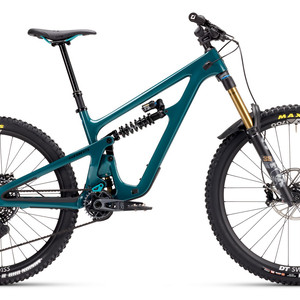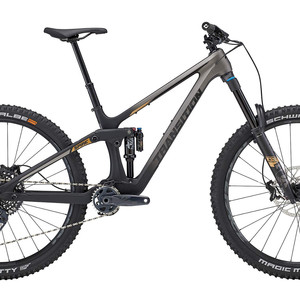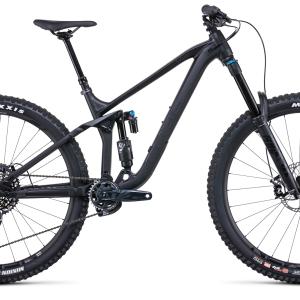2019 Pole Machine EN Bike
(discontinued)
| Where To Buy | |||
|---|---|---|---|
Free shipping on orders over $50 (continental U.S. only).
International shipping available. Some exclusions apply. |
|||
Free shipping on orders over $50 (continental U.S. only).
International shipping available. Some exclusions apply. |
|||

Over the past few years, wheel size, frame material, suspension design, geometry, and just about every other aspect of frame design has changed or been tweaked within any given brand. A quick glance at the pile of hub spacers in the toolbox only reinforces the reality that the only constant in the bike industry seems to be change. At Vital MTB, we believe that change is a good thing, but only if there is a discernible improvement over the products being replaced. If brands discover a better way of doing things we’re always keen to give something new a shot, especially if it makes riding more fun. In some cases, small changes seem to have little effect on the end user and we’d be grateful if they occurred more abruptly. Take geometry for example: it seems that just about every brand is making the same general changes of a longer reach, slacker head tube, and a steeper seat tube yet they often occur in isolation and by nearly negligible quantities. If a slightly longer wheelbase is more stable, is a much longer wheelbase even better? Is there a limit? Thankfully, Finnish brand Pole Bicycles is asking such questions and is willing to push boundaries not just for the sake of change, but for the sake of creating better, safer bikes.
During Crankworx 2018 we had the opportunity to sample the Pole Machine and chat with designer Leo Kokkonen about his latest bike. Even though little insight was gained in that single ride, we were curious to spend more time aboard the Machine to determine whether Kokkonen’s creation could live up to the expectations he had set. Fortunately, a Pole Machine arrived on our doorstep mid-winter and we have been delving into the advantages and limitations that come along with a bicycle that pushes boundaries ever since.
Strengths | Weaknesses |
|
|
Pole Machine Highlights
- CNC machined 7075 aluminum frame
- 29-inch wheels
- 160mm rear travel // 180mm front travel
- Evolink suspension
- Boost 12x148mm rear hub spacing
- 3.0” tire clearance
- Low standover height
- Three bottle mounts
- Limited lifetime warranty
- Actual Weight: 32.4-pounds (14.7kg, size large, no pedals)
- MSRP: 5887 EUR (excluding VAT and shipping)
Geometry
While Pole Bicycles have no doubt done their homework and tested competitors’ bikes, it is evident that the design process for the new Machine began from a blank slate, but with a clear vision and one that differed from the majority of what is currently on the market. In some cases, “new” frames are eerily similar to the competition, but not this one. Pole tested the waters of the long, low, slack movement with their original Evolink, and with the Machine they’ve once again chosen to dive right in. To some, certain dimensions of the Machine may seem overkill for daily driving: wheelbase, reach, chainstay length, and seat tube angle being the most common points of discussion. In reality, while the Machine’s geometry is a departure from industry norms it worked very well for us and felt comfortable from the get go, albeit a little bit different than what we were used to.

For example, while the 79-degree seat tube angle is steeper than most bikes we have ridden, our seated pedaling position remained unchanged. How do the cumulative changes affect overall pedaling position one might ask? We found the Machine’s geometry offered a number of advantageous traits:
- Improved pedaling biomechanics (i.e. easier to activate glute muscles, hip extension more powerful, less reliance on quadriceps, etc.)
- Less leverage on rear suspension while seated pedaling (i.e. less pedal bob)
- Weight distributed evenly between the wheels, which improved our balance
- More comfortable body position (i.e. less hip hinge required for steep climbs, less need for shifting forward on the saddle during steep climbs)
- Seat isn’t between rider’s legs when slammed because it is farther forward (i.e. less interference with the rider while descending)
The other major difference between the Machine and most other frames we have ridden is the wheelbase. The Pole is slacker, has more reach, and has longer chainstays than the majority of 160mm bikes…by far. For the sake of comparison, the head angle is 2-degrees slacker than the Kona Process 153 29 CR/DL we previously tested, plus the Machine has 35mm more reach and 30mm longer chainstays. In sum, the size large Machine we tested has a 1335mm wheelbase compared to 1218mm for the Kona even though they both target the same market segment. In the flesh, the geometry differences appear to be significant, however Kokkonen’s rationale is simple: the Machine is more stable, safer, more confidence inspiring, and as a result faster in the hands of those who choose to race it.

Initial Impressions
The Pole Machine attracts attention for a number of reasons. The weld-free, swooping aluminum frame is striking, and while carbon seems to be the most sought after material for frame construction, this “outdated” alloy attracted admiration from onlookers everywhere we took it. While it may be aluminum, similarities to the frames of yesteryear end there. The Machine features 7075-aluminum, which has an improved strength-to-weight ratio than the more commonly used 6061-aluminum. The challenge with this aluminum is that it introduces a number of problems when welding it, so Pole chose to machine their frames in-house and bond them rather than weld them, a first for the mountain bike industry. Kokkonen has been transparent and candid about his choice to go this route in his online articles and vlogs. An added bonus with in-house production is that Pole Bicycles controls the entire process under one roof. Need a prototype link? No problem. Custom geometry? Easy. Completely new frame? Yup, that too. For a tinkerer like Kokkonen, the manufacturing process utilized on the Machine just makes sense.


Rider preferences and personal tastes aside, the Machine is easy to ride fast, provides a massive amount of confidence, and sacrifices very little at slower speeds.
With a 180mm fork, Huck Norris tire inserts, and DH-worthy components, it is not a question of whether or not the Machine ought to descend well. The question is how well and compared to what? On our first descent, we appreciated that the saddle is completely out of the way while lowered because of the steep seat tube angle. In some cases, even a 170mm dropper can still impede range of motion, but not with the Machine. Like when climbing, the geometry of the Machine situates the rider almost directly between the wheels while descending, which gave us the confidence to stay put and just let the bike do its thing regardless of how steep or rough things got. Because we could remain centrally located, it was easy to maintain good body position through the worst that Squamish’s trails could dish out, and we found ourselves riding assertively into whatever we came across. Under heavy braking, the rear wheel remained planted and never chattered about and once on edge the bike delivers cornering traction in spades. The wheelbase, riding position, and suspension provide outstanding descending manners, with the Machine tracking smoothly on terrain that would upset most bikes. The stability on the ground also translated to the air, as we experienced no issues hitting short lippy jumps nor longer ramps. Rider preferences and personal tastes aside, the Machine is easy to ride fast, provides a massive amount of confidence, and sacrifices very little at slower speeds.
Timed Testing
With “how well” having been answered, the next piece we chose to address is “compared to what?” All things being equal, Pole believes the Machine is a safer, more confidence inspiring, and ultimately faster than the competition, so we decided to put that claim to the test. For the purpose of this test, we picked a variety of tracks including tight and awkward ones where speeds are slow and theoretically, a big bike like the Machine might suffer, along with others where we expected the Machine to perform well. Here is what we came up with:

Before we move on, it is worth noting that we had spent quite a bit of time aboard the Machine prior to timing these trails. We are willing to bet we could have closed the gap between the Kona and Trek compared to the Pole with more time. In the case of the 16-second differential to the Norco, we are not surprised to see such a gap since Cliff's Corners are less about turns and more about pedaling efficiency.

Whether racing the clock or just riding for kicks, the Pole Machine is quite the bike. Those looking for a super active, playful, and agile ride will not necessarily gravitate towards the Machine and for good reason. Sure, it manuals and can square off a corner from time to time, but there are better tools for those who prefer to jib and play. The Machine is akin to a big, stable, directional ski and it really impressed us with how nonchalantly fast it is. It carries speed through rough terrain and provides so much traction that we found ourselves hitting sections more confidently and quicker than usual. From amateur to elite, the Machine could be a single bike solution as a daily driver or dedicated race bike. Descending prowess aside, the Machine is also a comfortable all-day pedaling bike that is just as efficient on the way back up for a second, third, and fourth lap.
Build Kit

Pole Bicycles is known for their attention to detail with frame construction, so it should not come as a surprise that build kits for the Machine are a thoughtful combination of components, with specific end-users in mind. Whether money is no object or seeking a more affordable option, all three build kits feature proven parts that will allow a buyer to ride worry free.


Our test bike featured the no-compromise EN build, with the addition of Huck Norris tire inserts in both tires. RockShox takes care of suspension duties front and rear, and worked as advertised for the duration of our time aboard the Machine. One item of note is the 180mm travel Lyrik, which may seem like overkill, but we found it a good match for such a capable frame. Like the fork, the SuperDeluxe shock is well-mated to the Machine as this modern air shock has plenty of progression without sacrificing the beginning of the stroke. We set it up easily using Pole’s recommended setup as a baseline, and plenty of room remained for tweaking to personal preference.
In the end, Pole has done a great job of choosing components that can withstand aggressive riding, and we experienced no issues or setbacks related to any of the components during our time aboard the Machine.
Things That Could Be Improved
There aren’t many things that we would change on the Machine. A couple of items that we noted would be a simple plug of some kind for the unused cable routing locations. We did not experience any performance loss nor did we see any effects on the frame, we simply do not love the idea of water and debris getting into such a significant investment unnecessarily. Kokkonen is aware of this possibility and noted that he prefers the aesthetics of the frame without, in addition to having enough holes to flush dirt out of the frame in the event that it gets in. For the same reasons, it would be great if at some point there were dust covers on both sides of the frame bearings. Pole Bicycles has added this feature to their new Stamina frame, so we would not be surprised to see this update at some point on the Machine.
We have commented on tires with other reviews, but it rings even more true with the Machine: a modern enduro bike dishes out more than Maxxis EXO casing tires can handle. Huck Norris inserts were a nice addition and provided some rim protection, but we would much rather run a more robust tire for durability and trail feel. Our EXO tires ended up with a few punctures during the test period, which might be avoided with a stouter casing.
Long Term Durability
Pole raised a few eyebrows by utilizing their unique frame production technique. After a few months of abuse and with zero maintenance, we are confident that the CNC machining and bonding process is as durable as anything we have tested previously. The Machine has taken everything we have thrown at it to date, and the frame still performs as it did when new. Pole Bicycles has refined the bonding process further, and they are currently producing a short travel Stamina without the screws found on the Machine. We're actually testing that bike at present so we'll have more to report on in the future, but our experience thus far has led us to believe Pole has frame construction dialed in either case. We will point out that the bearings may have started creaking a little bit earlier than on other frames, the aforementioned lack of proper dust covers surely to blame here. The Stamina frame we're testing now does feature an improvement in this area, by how much remains to be seen.
One minor durability detail we noted is that the lower link of the Machine lost some of the gloss finish, but it is purely cosmetic.
What’s The Bottom Line?
At times, the term “innovative” is utilized too liberally and perhaps without just cause. With the Pole Machine, we are comfortable with this description as construction methods, geometry, and minor details that stray from the norm, aren’t just for the sake of being different, they make the bike better and include sound rationale to back up the choices made. We were impressed by the climbing efficiency, descending prowess, and just how well-mannered it was for what appeared initially as a lot to handle. The Machine has a few notable traits that deserve kudos, but what impressed us most is just how easily it carried speed. If rough, all-out tracks are your thing, and you’re keen to earn your turns, the Pole Machine is certainly worth a close look.
Check out www.polebicycles.com for more information.
Vital MTB Rating
- Climbing: 5 stars - Spectacular
- Descending: 5 stars - Spectacular
- Fun Factor: 4 stars - Excellent
- Value: 4 stars - Excellent
- Overall Impression: 4.5 stars - Outstanding
_________________________________________________________________________
About The Reviewer
Joel Harwood – Age: 35 // Years Riding: 20+ // Height: 5’11” (1.80m) // Weight: 185-pounds (83.9kg)
Joel’s unique coaching background and willingness to tinker with products bring an objective perspective to testing. He dabbles in all types of racing, but is happiest simply exploring the limitless trail networks surrounding his home of Squamish, BC. Attention to detail, time in the saddle, and an aggressive riding style make Joel a rider that demands the most from his products while exposing any shortcomings.
Photos by Jessie McAuley
Specifications
Rear: Maxxis Minion SS 29x2.3", EXO, TR
Paint, anodize and decals: 1 year
Fork and swing arms: 5 year
External cable routing with stealth dropper post routing
| Where To Buy | |||
|---|---|---|---|
Free shipping on orders over $50 (continental U.S. only).
International shipping available. Some exclusions apply. |
|||
Free shipping on orders over $50 (continental U.S. only).
International shipping available. Some exclusions apply. |
|||




















14 comments
Post a reply to: Redefining Boundaries - We Test the Super-Long and Ultra-Slack P